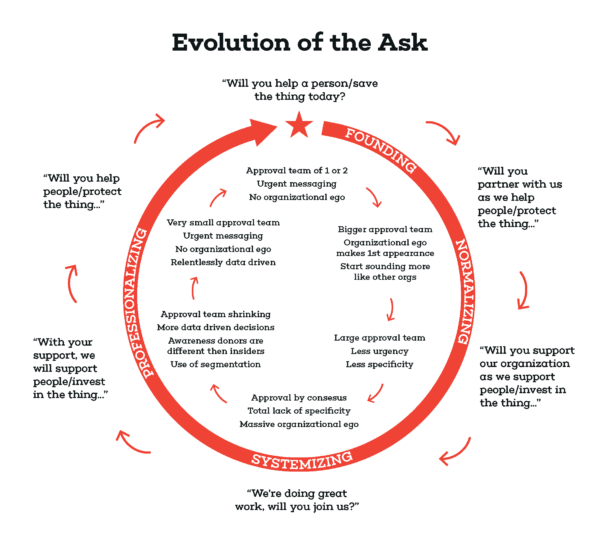I want you to identify which part of the circle your organization is currently in.
And before I go too far, let me just say that the graphic above doesn’t apply to every organization. Nor is it exactly right.
But it’s still true.
At their founding, organizations tend to have remarkably simple and powerful asks / calls to action.
These are phrases like:
- Help save the grizzlies!
- Will you give so that the Opera can put on the next performance?
- Will you help the Quilting Museum keep the doors open?
Simple. Clear. Powerful.
It works so great that the founder’s idea, plus their passion, raise enough funding to become an organization. That’s an incredible transformation!
And then, as organizations get bigger, they move around the circle to the right. Their fundraising and the team creating it gets more complex. Their ask evolves.
It’s a well-worn path.
Internal forces cause the asks above to evolve into less effective asks like:
- Our work in the local ecosystem with multiple bear species is such a success, will you join us?
- Will you support the light, drama and majesty of this art form we call “Opera”?
- Please join the beautiful patchwork of the human quilt!
Let’s be clear: these things happen for good reasons with good intent. Creative and passionate people, with little-to-no training in direct response fundraising because our industry doesn’t do a great job of that, do the best they can.
And it works. The team works hard. Donors are generous and support the things they love. The organization raises money.
But in the context of direct response fundraising (your appeals, e-appeals, newsletters, etc.) it doesn’t work as well as the simple, clear, powerful approach.
This graphic exists so that your organization can skip a few steps on the journey back to simple, clear, powerful fundraising that works like crazy.
So, go back to the graphic and locate your organization again. Think about where you currently are, and what steps you can skip. If you can skip a step or three, you’ll rapidly increase your organization’s fundraising capacity!

